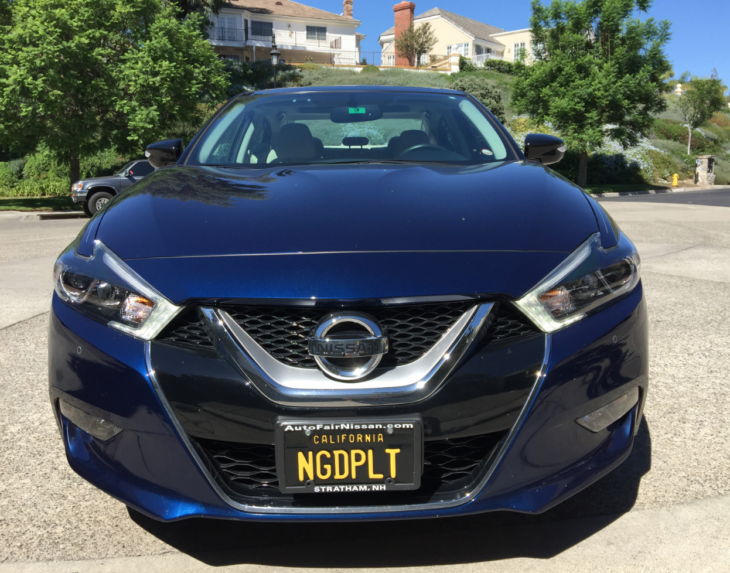
Obviously not. It occurred 9 months into the recession and several months into the most severe phase of the recession. Even by August 2008, unemployment had nearly reached the peak level of the previous recession:
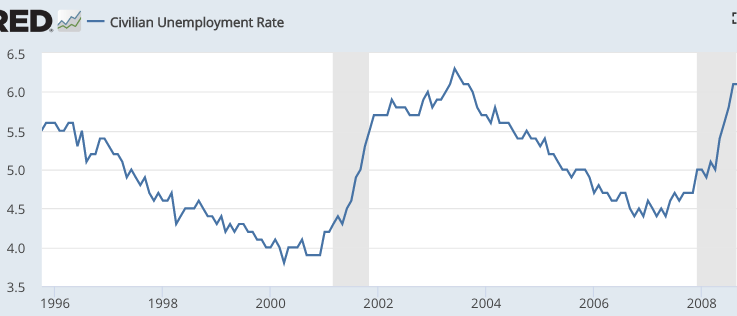
As we come up on the 10-year anniversary of Lehman, we can expect a flood of essays that point to this bank failure as a pivotal event in the Great Recession. Don’t believe them.
[Update: Stephen Kirchner also pushes back against the standard narrative.]
I’m very pleased to announce that Mercatus is publishing a new paper by David Glasner, which contains some quite interesting empirical work on the Great Recession. Here is the abstract:
This paper uses the Fisher equation relating the nominal interest rate to the real interest rate and expected inflation to provide a deeper explanation of the financial crisis of 2008 and the subsequent recovery than attributing it to the bursting of the housing-price bubble. The paper interprets the Fisher equation as an equilibrium condition in which expected returns from holding real assets and cash are equalized. When inflation expectations decline, the return to holding cash rises relative to holding real assets. If nominal interest rates are above the zero lower bound, equilibrium is easily restored by adjustments in nominal interest rates and asset prices. But at the zero lower bound, nominal interest rates cannot fall, forcing the entire adjustment onto falling asset prices, thereby raising the expected real return from holding assets. Such an adjustment seems to have triggered the financial crisis of 2008, when the Federal Reserve delayed reducing nominal interest rates out of a misplaced fear of inflation in the summer of 2008 when the economy was already contracting rapidly. Using stock market price data and inflation-adjusted US Treasury securities data, the paper finds that, unlike the 2003–2007 period, when stock prices were uncorrelated with expected inflation, from 2008 through at least 2016, stock prices have been consistently and positively correlated with expected inflation.
I’ve always been a fan of studies using time-varying correlations. Recall that in macro it’s very hard to establish causality, because so many things are going on at the same time. Thus if investment is correlated with GDP, it might be because investment drives the business cycle, or it might be because businesses react to changes in sales by adjusting investment.
In some cases, a model has causality claims that apply in one scenario, but not another. Thus in David’s model, higher inflation expectations don’t always bode well for the economy, but are likely to be seen as a positive indicator when in a deep recession where monetary policy is currently too contractionary (perhaps due to the zero bound problem.) David’s work focused on how the zero bound problem could prevent macroeconomic equilibrium from occurring, which is one interesting perspective. Here I’d like to emphasize a very important implication of his empirical findings, that monetary stimulus would have had a positive impact on stock prices during 2008-16, but not during 2003-07.
When David first mentioned these empirical result in a blog post, Paul Krugman was very impressed:
Scott Sumner sends us to David Glasner, who shows that stock prices have had a positive correlation with expected inflation since 2008, strongly suggesting that aggregate demand is at the heart of our problems.
I really like this kind of argument. For me, the case for a sticky-price, Keynes-Friedman view of the world rests crucially on some of the correlations one sees in the real world — between real and nominal exchange rates, for example. And this is a good modern example.
Krugman’s right that a big drop in aggregate demand caused the Great Recession. Of course that doesn’t entirely rule out Lehman playing a big role, as it might have reduced AD. But on close inspection, it was tight money that was the real problem. The early (and milder) phase of the Great Recession occurred between December 2017 2007 and June 2008. Real GDP leveled off during this 6-month period. The proximate cause was a sharp slowdown in NGDP growth, from 6.5% during the housing boom, to just below 3%:
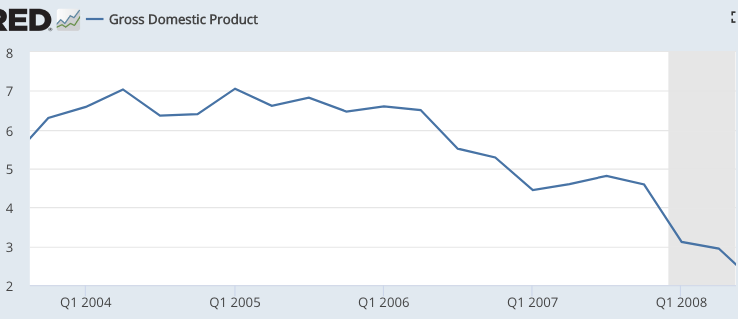
The proximate cause of the slowing NGDP growth was a nearly complete stop in growth in the monetary base from July 2007 to May 2008 (this graph shows 12-month growth rates):
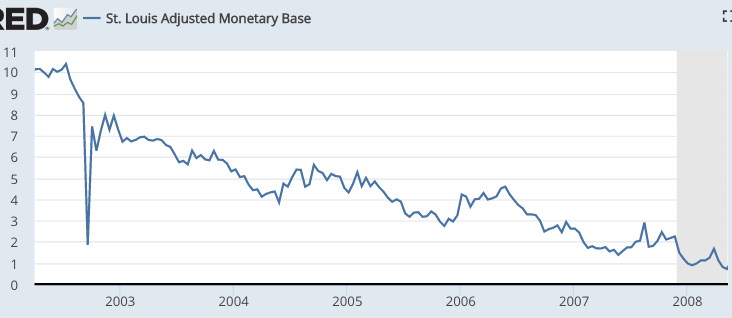 Base velocity actually increased during late 2007 and early 2008. The slowdown in NGDP was entirely caused by the Fed’s decision to stop printing additional currency during late 2007 and early 2008. (In those days the base was roughly 98% currency.)
Base velocity actually increased during late 2007 and early 2008. The slowdown in NGDP was entirely caused by the Fed’s decision to stop printing additional currency during late 2007 and early 2008. (In those days the base was roughly 98% currency.)
After mid-2008, two other problems developed:
1. The Fed did not print enough base money to meet the rising demand for cash (falling velocity), which was caused by a fall in the opportunity cost of holding cash.
2. In early October 2008, the Fed began paying interest on bank reserves, further boosting the demand for base money.
If you are one of those people still unenlightened by market monetarism, someone who insists on thinking in terms of interest rates, note that during April-October 2008 the Fed held its target fed funds rate at 2%, even as the natural rate of interest fell sharply into negative territory. (See the graph below from a paper by Vasco Curdia, which shows a negative natural rate during mid-2008.) Thus in New Keynesian language, the severe phase of the Great Recession was caused by the Fed’s decision to hold their target rate at 2%, while the natural rate had plunged into negative territory.
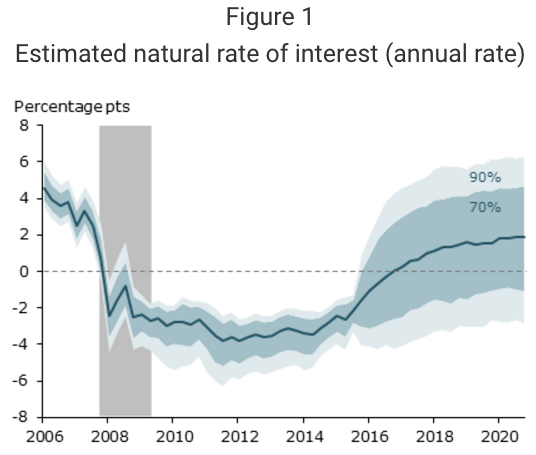
Notice that this problem occurred well before Lehman. This doesn’t mean the failure of Lehman had no effect; it probably slightly reduced the global Wicksellian natural interest rate. But the Fed could have and should have offset that effect. Lehman was much more a symptom than cause of the Great Recession.
The cause of the recession was tight money leading to falling NGDP growth, which (because of sticky wages) led to falling RGDP growth.
I’ve included “concrete steppes” in this post because commenters always ask for them. But in truth, the concrete steps are beside the point. As Ben Bernanke pointed out in 2003, NGDP growth and inflation (not the money supply or interest rates) are the best indicators of the stance of monetary policy:
As I discussed earlier, for reasons of financial innovation and institutional change, the rate of money growth does not seem to be an adequate measure of the stance of monetary policy, and hence a stable monetary background for the economy cannot necessarily be identified with stable money growth. Nor are there other instruments of monetary policy whose behavior can be used unambiguously to judge this issue, as I have already noted. In particular, the fact that the Federal Reserve and other central banks actively manipulate their instrument interest rates is not necessarily inconsistent with their providing a stable monetary background, as that manipulation might be necessary to offset shocks that would otherwise endanger nominal stability.
Ultimately, it appears, one can check to see if an economy has a stable monetary background only by looking at macroeconomic indicators such as nominal GDP growth and inflation.
Note that if the Fed had engaged in 5% NGDPLT in 2008, then the natural rate of interest never would have fallen into negative territory.
BTW, I got my new California license plates yesterday. In an amazing coincidence, California chose a set of letters that exactly correspond to my policy preferences. I’ll take that as a sign that I’m on the right track.


READER COMMENTS
John Hall
Sep 11 2018 at 4:51pm
I haven’t read the whole paper by David yet, but I would take it with a grain of salt. TIPs yields were notoriously unreliable during this period (b/c banks were looking for anything they could sell and those were one of the few safe assets they could sell). He acknowledges it, but it’s a big enough issue to call into question the entire analysis.
Scott Sumner
Sep 11 2018 at 5:35pm
John, Actually, that was only a major problem for a short time in late 2008.
He focuses on the TIPS spreads, and non-indexed Treasuries were another safe asset that was easy to sell.
Keenan
Sep 11 2018 at 6:18pm
Scott, apologies as I’m one of the commenters who has asked for “concrete steps” in the past. Thank you.
I’m relatively new to macro, but could you indulge me further and explain why, as David Glasner says, “But at the zero lower bound, nominal interest rates cannot fall”. Can’t interest rates just go negative? Is it illegal for rates on a loan to be negative?
Airman Spry Shark
Sep 11 2018 at 7:54pm
The erstwhile lender would, in that case, have more money at the end of the loan period if they just held onto the cash; given that fact, nobody will give a negative-rate loan.
Matthias Goergens
Sep 14 2018 at 1:38am
But apart from straight up physical dollar bills, there’s no way to just hold cash. It’s always a loan.
(Reserves at the Fed might be different. But we are exactly talking about the Fed imposing negative interest rates on the rest of the economy.)
B Cole
Sep 11 2018 at 8:13pm
Go NGDPLT. And think big.
Kurt Schuler
Sep 11 2018 at 11:38pm
Lehman didn’t cause the recession, but it signaled the beginning of a worldwide financial panic, unequaled at least since 1931. Because the panic affected the two largest financial centers, the United States and Western Europe, it threatened to drag the financial system of the rest of the world down with it. There have been plenty of recessions without financial panics. I can accept that the U.S. recession up to the failure of Lehman Brothers was a failure of monetary policy, but the financial panic phase, which almost resulted in another Great Depression, was to a large extent the fault of bad risk management practices by many financial institutions. They were undercapitalized, did a terrible job of credit analysis, and relied too much on rolling over short-term credits. One needs Minsky as well as Sumner to understand the events of 2008-09.
Scott Sumner
Sep 12 2018 at 2:43am
Kurt, Nominal and real GDP grew rapidly during the last 9 months of 1933, despite one of the worst banking crises in American history. I’m not disputing that a financial crisis can have real effects even without a fall in NGDP, however I’d make the following two claims:
The fall in NGDP (i.e. tight money) was large enough to mostly explain the Great Recession, even if there had been no financial crisis at all.
If monetary policy had kept NGDP growing at 5%/year, then the financial crisis would have been far milder.
Put these two points together, and I’d insist that monetary policy is of overwhelming importance, and banking was mostly a symptom.
As an analogy, we also saw a huge plunge in global trade during 2008-09. That sort of decline in trade is normally associated with a severe recession., However, the sharp plunge in global trade did not cause the recession, it was a symptom.
Kurt Schuler
Sep 13 2018 at 10:43pm
Scott, you note that nominal GDP grew rapidly in the last nine months of 1933. That was after the banking crisis, not during it. Accordingly, it’s not a good analogy to what I mentioned, which was specifically the financial panic that began with the failure of Lehman Brothers.
In what I have read by you, you have not described how NGDPLT would work during a financial panic. It happened that last night I was listening to a radio broadcast of Ben Bernanke, Tim Geithner, and Hake Paulson describing their thinking during the panic. Bernanke and Geithner did not think Lehman Brothers had enough recognizably good assets for a loan. What would you have told Lehman? They came to the Fed precisely because they couldn’t go to the market and receive anywhere near what the value of their assets would be if they could ride out the panic. What would you then have told other institutions that soon afterwards knocked on the Fed’s door, also with dodgy assets by the conventional standards of central banking?
I don’t know of any monetary system that has been free of financial panics. Even under NGDPLT operating according to your rosy expectations I am confident that there would be a Lehman moment somewhere, sometime, so it would be useful to know how you would propose to handle it.
Finally, although I find it plausible that the Fed’s policies made Lehman Brothers more likely to fail, nobody forced them to take the big risks they did. Prudent managers should be prepared for possible adversity. Hence the managers of Lehman Brothers and other firms that failed or would have failed but for government bailouts deserve a great deal of criticism for poor strategy.
Matthias Goergens
Sep 14 2018 at 1:42am
Market monetarists are generally fine with banks going belly up. The whole point is that a stable nGDP trajectory will protect the rest of the economy from fallout.
Basically nothing. Just keep nominal GDP stable, and let the banks fail. Not sure if Scott Sumner ever said that directly, but plenty of other market monetarists have.
Matthias Goergens
Sep 14 2018 at 1:45am
What monetory systems do you know? George Selgin has good stuff about the historic free banking episodes of Scottland, Australia, Canada and a few other countries. They were (almost) free of financial panics.
(Interestingly George Selgin also argued how free banking can and did stabilise nominal GDP. Scott Sumner expressed some sympathy for the view.)
Scott Sumner
Sep 16 2018 at 12:11pm
Kurt, The banking crisis continued throughout much of 1933, as many banks were closed down for long periods of time before re-opening.
The Fed should not focus on preventing individual bank failures, as that simply creates moral hazard. Rather they should provide enough liquidity to the banking system to maintain stable NGDP growth expectations. (Whatever it takes) If they do so, then the banking problems at Lehman would not have brought down the entire system. But the Fed failed to do that. Even worse, THEY NEVER EVEN TRIED. The adoption of interest to reserves(after Lehman failed) was intended to prevent NGDP from rising. They were actually worried about inflation during this period.
I agree that there will still be financial panics under NGDP targeting (although less frequent.) My solution is to allow the bad banks to fail, and provide enough liquidity to prop up NGDP growth. Ideally we’d get rid of FDIC, but that’s a hard sell.
Iskander
Sep 12 2018 at 12:58am
This post makes a point that’s well overdue.
Nice numberplate Scott!
Marcus Nunes
Sep 12 2018 at 7:15am
Lehman was more likely a victim. Unfortunately many still sing Fed praises!
http://ngdp-advisers.com/2018/09/09/ten-years-later-they-still-have-the-wrong-perspective-on-the-2008-crisis/
Scott Sumner
Sep 13 2018 at 12:06pm
Exactly.
Marcus Nunes
Sep 12 2018 at 7:18am
I believe in some places you can have different front and back plates. The ideal companion would be MV=Py
Alan Goldhammer
Sep 12 2018 at 8:36am
I have not read it but Ray Dalio of Bridgewater Associates has a new book out, “A Template for Understanding Big Debt Crises.” You should be able to get a free PDF from his website. There was an extensive interview on this topic yesterday on CNBC and one can just do a Google to get the stream.
Philo
Sep 12 2018 at 9:02am
The response will be that Lehman caused the Great Recession to be Great, rather than mild. Of course, this is plausible only if we are stipulating some fixed, and suboptimal, monetary policy. Remarkably few people realize that in a fiat-money system recessions are (in practice) always caused by poor monetary policy.
Pepe
Sep 12 2018 at 11:53am
This analysis ignores the gorilla in the room.
There was an enormous volume of bad housing debt accumulating within the financial system. There were contemporaneous comments in bank research and rating agencies reports trying to explain why structured finance was continuing to grow though fundamental credit metrics and spreads were declining from 2004-5 onward.
Even if you do not believe there was some skepticism about the housing market before the crisis the reality was always going to be a very painful resolution of a credit overhang. Even assuming interest rates were dropped to zero or negative before Lehman’s and others were to default the outcome would have been a horrible slowdown similar to the European Debt crisis. Is their experience any better? In fact their Government Debt crisis is still not resolved.
The danger of these massive monetary interventions is that it will only forestall the reckoning with an underlying indebtedness crisis.
Alan Goldhammer
Sep 12 2018 at 12:21pm
I forgot to add to my previous post that Minsky’s “Stabilizing an Unstable Economy” is worth reading though not being an economist I don’t know how much it fits in with Scott’s license plate.
Mark Bahner
Sep 13 2018 at 12:37am
Somehow, that looks wrong. 😉
Cloud
Sep 13 2018 at 5:23am
Ben Bernanke, as expected, has a differect view from yours. Though he is not blaming the Lehman, but he is blaming the run in financial market.
Here is he explain that in an interview with David Wessel:
https://www.youtube.com/watch?v=QcnlgaRdN84&t=40s
ChrisA
Sep 13 2018 at 7:42am
People love the morality tale of the standard explanation. It makes them feel superior to the dumb folks who screwed up by taking on too much debt. Scott’s explanation, while true, doesn’t have this advantage so probably will continue to ignored in popular media.
What I wonder is that Scott still seems to retain a lot of respect for Bernanke, although he actually seem to be the prime villain, he clearly knew about the mistakes of the 1930’s but went ahead and did the same again, which is somewhat even worse than the 1930’s because at least they didn’t have the benefit of his experience.
Scott Sumner
Sep 13 2018 at 12:03pm
Thanks Mark.
Chris, I think it makes more sense to say the Fed screwed up, rather than Bernanke screwed up. That’s not to let him off the hook, just to point out that he was pushing his colleagues to do more.
Jeff
Sep 13 2018 at 3:25pm
In practice, the Fed doesn’t decide how much currency to print. It’s actually passive. Banks with reserve accounts at one of the Federal Reserve Banks can withdraw reserves from their account either by crediting someone else’s reserve account, as they do when honoring checks presented to the ACH (Automated ClearingHouse) or they can take a withdrawal in the form of currency. So long as they still meet their reserve requirements, the Fed doesn’t care whether the deposits to and withdrawals from their reserve accounts are in the form bookkeeping entries or currency. In fact, currency held by banks as “vault cash” counts towards meeting the banks reserve requirements. (Many banks hold vault cash well in excess of their reserve requirements. In Fed parlance, these are known as nonbound institutions, as opposed to their bound brethren who meet some or all of their reserve requirements via their reserve accounts at one of the Federal Reserve Banks.)
Reserves in either form (currency or positive balances at the Fed, collectively known as the monetary base) are Fed liabilities. These liabilities are usually created by Fed purchases of securities, as it pays for such purchases by crediting the seller’s Fed account with reserves equaling the purchase price. The monetary base is, in effect, created out of thin air by the Fed. Similarly, when a bank buys a security from the Fed, it’s reserve account is debited to pay for it, and those reserves just disappear. The important point is that the Fed determines the total amount of base money by buying and selling securities, but it leaves it up to the preferences of it’s member banks to determine the split between currency and reserves.
If there is a stable demand for base money that depends on nominal GDP, then it’s easy to see that the Fed could target nominal GDP just by inverting the base money demand equation. However, if base money demand is not all that predictable and stable, the Fed needs some other way to figure out whether it should be creating or destroying base money to hit the target. Prediction markets for NGDP seem like the obvious answer.
Scott Sumner
Sep 13 2018 at 10:53pm
Jeff, That’s true, but keep in mind:
Prior to 2008, the base was 98% currency
The Fed does control the base.
New injections of base money used to quickly go out into circulation as currency (before 2008) due to the hot potato effect.
So I oversimplified, but only slightly.
I agree about prediction markets; targeting the money supply is not a good policy.
E. Harding
Sep 16 2018 at 3:17am
Lehman’s failure was certainly not the start of the recession. The public recognized the start of the recession to be in January 2008, due to skyrocketing oil prices (check Google Trends). However, Lehman’s failure ended the gag rule in the financial press against calling the already self-evident recession a recession. Before Lehman’s failure, recession denialism was a ubiquitous, if curious and expected feature of financial press coverage.
For the record, if you look at stock indices, it wasn’t the Lehman failure that started the Great Crash of 2008. It was the House’s rejection of the bailout plan on September 29.
Comments are closed.